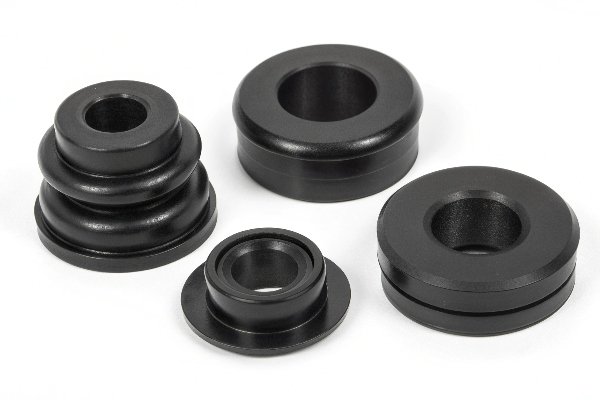Nitrile rubber (NBR) stands out in industrial applications due to its impressive resistance properties, but is it truly the best material for every scenario? Let’s explore its strengths and weaknesses.
Nitrile rubber (NBR) excels in oil, fuel, and chemical resistance. However, it comes with some downsides, such as reduced flexibility in cold environments and sensitivity to UV exposure.
To fully understand the pros and cons of NBR, we need to dive deeper into its properties and applications. Let’s explore how this rubber compares to others in more detail.
Is Nitrile Rubber the Same as Natural Rubber?
Nitrile rubber and natural rubber are both common materials, but they have distinct differences that affect their performance in various environments. So, how do they compare?
Nitrile rubber (NBR) is synthetic, made from acrylonitrile and butadiene, while natural rubber is derived from latex. These differences result in distinct performance characteristics.
Difference Between Nitrile Rubber and Natural Rubber
Nitrile rubber (NBR) and natural rubber are distinct materials that serve different purposes. While natural rubber is harvested from rubber trees, NBR is a synthetic rubber composed of acrylonitrile and butadiene, giving it specific advantages in oil and chemical resistance.
Natural rubber, with its excellent elasticity and flexibility, is widely used in tires and footwear. However, it is not resistant to oils or many chemicals, making it unsuitable for applications in environments exposed to petroleum-based fluids. NBR, on the other hand, is a better choice for sealing applications in automotive, aerospace, and industrial sectors due to its superior chemical resistance and low permeability.
| Property | Nitrile Rubber (NBR) | Natural Rubber |
|---|---|---|
| Origin | Synthetic (acrylonitrile and butadiene) | Natural (latex) |
| Oil Resistance | Excellent | Poor |
| Chemical Resistance | Excellent | Poor |
| Flexibility | Good at moderate temperatures | Excellent |
| Temperature Tolerance | -40°C to 100°C | -50°C to 120°C |
Is Nitrile Rubber Good?
Nitrile rubber is widely used, but is it the best material for every application? Let’s analyze its advantages and limitations in detail.
Nitrile rubber excels in environments requiring resistance to oils, fuels, and chemicals. However, its rigidity in colder temperatures may limit its use in certain applications.
Advantages of Nitrile Rubber
Nitrile rubber's strength lies in its oil and chemical resistance, which makes it ideal for use in automotive, fuel, and chemical industries. It’s used for O-rings, gaskets, seals, and hydraulic components due to its low permeability to oils, fuels, and solvents. NBR is also relatively durable in terms of abrasion resistance, which further extends its lifespan in demanding applications.
- Abrasion Resistance1: NBR is highly resistant to abrasion and wear, which ensures consistent performance, even under harsh conditions. It also possesses good tear resistance.
- Chemical Resistance2: NBR exhibits excellent compatibility with different oils, fuels, and industrial chemicals. NBR doesn't easily swell or degrade when exposed to oils, fuels, and petroleum-based fluids, making it a reliable material for applications that involve contact with these substances.
- Cost-Effectiveness: NBR combines affordability with excellent performance, providing industries with high-quality rubber solutions at a reasonable cost.
- Durability: NBR is known for its durability and long service life. Its mechanical strength extends the lifespan of components like seals and gaskets.
- Flexibility: NBR is highly flexible and can be easily molded into different shapes and sizes, making it suitable for a wide range of applications. Seals made from NBR also demonstrate good flexibility and are unlikely to be stretched during installation.
- Temperature Resistance3: NBR can effectively operate within a temperature range of -40°C to 120°C, making it a reliable choice for applications where components experience fluctuating temperatures.
- Tensile Strength: NBR has good tensile strength and elongation. Its tensile strength ranges from 3.5 MPa to 21 MPa, depending on the grade, and it has an elongation at break of up to 700%.
- Water Resistance: NBR has a closed-cell structure that provides an effective barrier against water absorption. This property makes it suitable for use in applications that require water resistance.
| Advantage | Description |
|---|---|
| Abrasion Resistance | High resistance to wear and tear. |
| Chemical Resistance | Excellent compatibility with oils, fuels, and chemicals. |
| Cost-Effective | Affordable with excellent performance. |
| Durability | Long service life and mechanical strength. |
| Flexibility | Easily molded into various shapes. |
| Temperature Resistance | Operates effectively from -40°C to 120°C. |
| Tensile Strength | Good strength and elongation properties. |
| Water Resistance | Effective barrier against water absorption. |
Disadvantages of Nitrile Rubber
While nitrile rubber has many advantages, it also has limitations. One major drawback is its reduced flexibility at low temperatures. NBR becomes brittle and loses its elastic properties when exposed to extreme cold, which can compromise its performance in some environments.
- Ozone and UV Instability: Susceptible to damage from ozone and ultraviolet radiation, leading to cracking and degradation. Not ideal for prolonged outdoor use.
- Chemical Incompatibility: Poor resistance to strong acids, ketones, chlorinated hydrocarbons, and nitro hydrocarbons, causing degradation and loss of sealing properties. Attacked by polar solvents such as acetone, ethanol, and acetic acid.
- Temperature Limitations: Standard NBR performs well from -40°C to 120°C, but may become brittle at lower temperatures and soften at higher temperatures. High-temperature resistance is limited compared to materials like silicone or fluoroelastomers.
- Poor Weather Resistance: Limited resistance to prolonged exposure to UV rays and ozone, potentially leading to surface degradation over time.
- Low-Temperature Flexibility: Loses flexibility and becomes stiff/prone to cracking below -40°C.
- Non-Biodegradable: As a synthetic material, it does not decompose naturally, raising environmental concerns. Requires proper recycling or disposal.
- Compression Set: Can develop a compression set under continuous pressure, reducing sealing force over time.
- Commercial Grade Issues: Some commercial grades are mixed with SBR, which lowers ACN content and reduces desired nitrile characteristics.
| Disadvantage | Description |
|---|---|
| Ozone/UV Instability | Cracking/degradation from ozone and UV exposure. |
| Chemical Incompatibility | Degrades with strong acids, ketones, chlorinated hydrocarbons. |
| Temperature Limits | Brittle at low temps, softens at high temps. |
| Poor Weather Resistance | Surface degrades with UV/ozone exposure. |
| Low-Temp Flexibility | Loses flexibility below -40°C. |
| Non-Biodegradable | Does not decompose naturally. |
| Compression Set | Sealing force reduces under pressure. |
| Grade Issues | Some grades mixed with SBR, reducing NBR qualities. |
How Flexible Is Nitrile?
Flexibility plays a critical role in the performance of many rubber products. How does nitrile rubber measure up in terms of flexibility?
Nitrile rubber is flexible but loses its elasticity at low temperatures. This can limit its usability in colder environments compared to other rubbers like silicone or EPDM.
Flexibility of Nitrile Rubber
Nitrile rubber (NBR) is moderately flexible under normal conditions. However, its flexibility decreases when the temperature drops. At temperatures below -40°C, NBR can become rigid and brittle, leading to cracking or failure in applications that require the material to stretch or flex.
For example, while NBR is widely used for seals and gaskets in automotive and industrial equipment, its brittleness in cold climates makes it less suitable for applications in regions that experience freezing temperatures.
| Temperature (°C) | Flexibility of Nitrile Rubber |
|---|---|
| -40°C | Brittle and Rigid |
| 0°C | Moderate Flexibility |
| 25°C | High Flexibility |
| 100°C | Reduced Flexibility |
How to Identify Nitrile Rubber?
Identifying nitrile rubber is essential to ensure you're using the right material for your application. Here’s how to distinguish it from other rubbers.
Nitrile rubber is typically identified by its oil resistance, blue or black color, and smooth texture. It’s commonly used in fuel systems and industrial seals.
Identifying Nitrile Rubber
Nitrile rubber (NBR) is usually black or blue, and it has a smooth, slightly oily texture. Unlike natural rubber, which has a more elastic feel, NBR is denser and firmer. It is most commonly used in sealing applications, where its resistance to oils, fuels, and solvents is a major advantage.
A simple way to identify nitrile rubber is by performing an oil resistance test. NBR is highly resistant to degradation when exposed to petroleum-based fluids, unlike natural rubber, which will break down quickly when exposed to oil.
What Is Nitrile Resistant To?
Nitrile rubber’s resistance to oils, fuels, and chemicals is one of its strongest attributes. But exactly what is it resistant to?
Nitrile rubber is resistant to a wide variety of oils, fuels, solvents, and chemicals, making it suitable for high-demand industrial applications.
Chemical Resistance of Nitrile Rubber
Nitrile rubber excels in applications that require resistance to oils, fuels, and solvents. It is highly resistant to a range of petroleum-based fluids, which makes it a popular choice for automotive and industrial seals, gaskets, and O-rings.
However, nitrile rubber is not resistant to ozone, sunlight, or UV radiation. Exposure to these elements can cause cracking, hardening, and eventual failure of the rubber.
| Substance | Resistance Level |
|---|---|
| Motor Oils | Excellent |
| Hydraulic Fluids | Excellent |
| Fuels (Gasoline, Diesel) | Excellent |
| Ozone | Poor |
| UV Radiation | Poor |
| Chemicals (Acids, Alkalis) | Good |
Does Nitrile Rubber Conduct Electricity?
For many applications, it’s crucial to know if a material conducts electricity. Let’s examine if nitrile rubber fits the bill.
Nitrile rubber is a non-conductive material, making it an excellent choice for electrical insulation applications.
Electrical Conductivity of Nitrile Rubber
Nitrile rubber is an excellent electrical insulator. It does not conduct electricity, which makes it ideal for use in electrical seals, gaskets, and cable components where electrical isolation is important. However, nitrile rubber’s insulating properties can degrade under extreme environmental conditions, such as exposure to UV light or ozone.
What Is the Maximum Temperature for Nitrile Rubber?
Understanding the temperature limits of nitrile rubber is critical for its performance in high-heat or low-temperature environments.
Nitrile rubber can withstand temperatures ranging from -40°C to 100°C, making it suitable for a variety of applications in automotive and industrial settings.
Temperature Resistance of Nitrile Rubber
Nitrile rubber’s temperature resistance typically ranges from -40°C to 100°C. This moderate range makes it suitable for many industrial applications, including automotive seals and gaskets, but not for extreme temperature environments. For higher temperature resistance, materials like silicone or fluorosilicone would be better alternatives.
| Temperature (°C) | Resistance of Nitrile Rubber |
|---|---|
| -40°C to 100°C | Excellent Resistance |
| 100°C to 120°C | Limited Performance |
| Above 120°C | Not Recommended |
Conclusion
In conclusion, nitrile rubber (NBR) offers numerous advantages in oil, fuel, and chemical resistance, making it a vital material in many industrial and automotive applications. However, its limitations in cold temperatures and UV resistance need to be considered when choosing NBR for specific use cases. By understanding its pros and cons, you can make an informed decision about whether nitrile rubber is right for your application.
Footnotes:
-
Exploring abrasion resistance will provide insights into material longevity and performance in harsh environments. ↩
-
Understanding chemical resistance can help you choose the right materials for your projects, ensuring safety and durability. ↩
-
Learning about temperature resistance can guide you in selecting materials that withstand extreme conditions effectively. ↩









